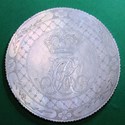For the past 20 years, Neal has been fascinated by them. Along with the two specialist books he has written, he sells online via ChezBill and at Adams Antiques Fairs at the Royal Horticultural Halls in London, where he will be stalling out on Sunday, May 14.
Neal says: “In the 18th century all society people played cards including Queen Charlotte, the court and the nobility as well as the middle and poorer classes. Voltarete was the most popular game and also Pope Joan, Hombre and Quadrille.
“Chinese gaming counters were available for all types of people, ranging in quality and price, from the counters made for the queen to the mass-produced counters made in Canton by the thousands.
“They were always made of mother-of-pearl from shells from the Pacific Islands, cut, carved and decorated by hand to incredibly high standards. Later sets included to the reverse scenes of Chinese life, as this was when chinoiserie was all the rage. The Prince Regent, later George IV, was commissioning Brighton Pavilion and furnishing it with everything Chinese.”
Private gaming
The counters were used in private homes, not generally in gaming clubs, Neal adds.
The stakes were set at the start of the game, so each counter would be allocated a value at anything from a penny to 100 guineas or even more.
Neal says: “It was the height of fashion for a lavish meal to be served on Chinese porcelain with the owner’s coat of arms and afterwards a servant would ceremonially bring in the games box, often made of beautiful Chinese lacquer, which contained the counters. The gentlemen would then retire to play cards.”


















